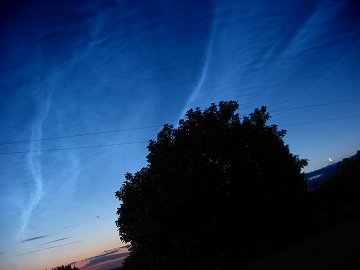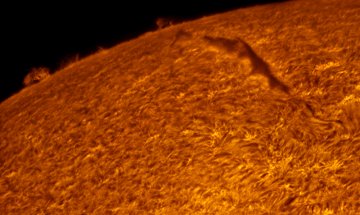 The space shuttle will fly over the United States in July. Would you like to see it? Sign up for Spaceweather PHONE.
The space shuttle will fly over the United States in July. Would you like to see it? Sign up for Spaceweather PHONE.
NYX AND HYDRA: Finally, some names we can remember! Pluto's two new moons, formerly known as S/2005 P1 and S/2005 P2, have been officially christened Nyx and Hydra. In Greek mythology, Nyx is the goddess of night, while Hydra is a terrifying serpent with nine heads. These seem like good companions for Pluto, ninth planet and Roman god of the Underworld.
ELECTRIC-BLUE SKIES: Last night, bright noctilucent clouds swept across northern Europe. "'I stepped outside at 2 o'clock in the morning and witnessed a great display--the best I have ever seen!" says Alex Lloyd-Ribeiro of Durham, UK.

Photo credit: Alex Lloyd-Ribeiro of Durham, UK. June 23rd.
Summer is the season for noctilucent clouds (NLCs) and, true to form, the summer solstice on June 21st kicked off three straight nights of electric-blue. For reasons as mysterious as the clouds themselves, these displays have been concentrated over northern parts of Europe. The comings and goings of NLCs are not well understood, so watch for them no matter where you live.
DARK FILAMENT: Sunspot 896 has dissolved and the sun is now blank. Or is it? A dark filament larger than any sunspot has crept over the sun's southeastern limb:

Photo credit: Gary Palmer of Los Angeles, CA.
Filaments are distant cousins of sunspots, related by magnetism. Sunspots are magnetic islands floating on the surface of the sun; filaments are magnetized clouds floating above the surface. Islands and clouds? It sounds very Pacific--and it would be except for the boiling sea. All these things are easy to see if you have a solar telescope. Take a look.
more images: from Emiel Veldhuis of Zwolle, the Netherlands; more Rogerio Marcon of Campinas - SP - Brazil.

